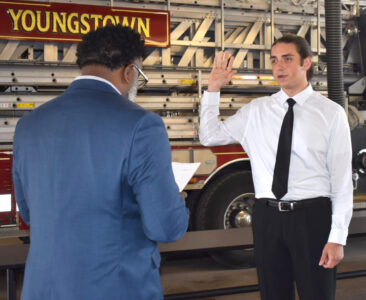Former trooper takes the stand in Malvasi trial

Staff photos / Ed Runyan Attorney John Juhasz, left, confers with Michael Malvasi II during Malvasi’s vehicular homicide trial Monday in Mahoning County Common Pleas Court.
YOUNGSTOWN — Testimony Monday in the Michael Malvasi II vehicular homicide trial came from former state trooper Christopher Jester, who carried out a reconstruction of the accident that killed Ryan Lanzo early Nov. 18, 2017, in Canfield Township.
The testimony came as the Malvasi trial in Mahoning County Common Pleas Court entered its second week. Jester worked for the Ohio State Highway Patrol at the time of the crash but now does similar work in the private sector.
Malvasi, 30, is accused of crashing his father’s Mercedes Benz on Shields Road, leaving the scene, returning in another car to pick up Lanzo and driving Lanzo to Malvasi’s Canfield home — all without calling 911.
The Ohio State Highway Patrol has said Malvasi’s father, Michael Malvasi, now 59, then drove Lanzo to a St. Elizabeth emergency center in Austintown, where Lanzo was pronounced dead.
Last week, in opening statements, Michael Malvasi II told jurors he was not the driver.
Jester testified for about three hours Monday, saying a “semi-circular” injury on Lanzo’s left leg is “consistent with” Lanzo being ejected from the car through the sunroof of the Mercedes Benz and having gotten “caught” on the semi-circular left rear part of the sunroof as the car rolled after hitting a pine tree.
Jester testified that his investigation of the crash, including his study of photographs of Lanzo’s injuries, indicated that Lanzo was the front-seat passenger.
Malvasi is charged with six offenses, including failure to stop after an accident, tampering with evidence and drunken driving.
Under questioning by Rob Andrews, assistant county prosecutor, Jester described the damage to the roof of the car and then described the “semi-circular” injury on Lanzo’s leg that Jester said is “very similar” to part of the sunroof.
Jester said Lanzo’s leg also had an injury at a 25-degree angle “that is very similar to a support arm that is mounted at this corner of the sun roof.”
Separate images of Lanzo’s leg and the sunroof-area of the car were shown to jurors on a screen.
Jester said the vehicle was traveling at about the 45 mph speed limit but left the roadway on a curve and hit a pine tree near the front-right wheel. The tree, about eight inches in diameter, was sheared off, Jester said.
The vehicle rolled left at least two times, which would have thrown Lanzo and Malvasi up and to the left of their seated positions. The driver of the car would have been thrown toward the driver’s door, he said. Photos of the car showed a deployed air bag between the driver’s seat and the driver’s side window.
The condition of the seat belts indicated neither was being used, Jester said.
Jester also described four injuries on Lanzo’s left ankle that he said were “very similar” to an area of the sunroof where he believed Lanzo’s leg got caught as he was being ejected.
Projected on the screen were the black denim jeans Lanzo was wearing and the “damage” to the denim that “correlate” to the damage on the victim and the the dashboard on the passenger side of the car, Jester said. Skin and hair were still attached to the inside of the pants, he said.
In cross examination, defense attorney John Juhasz asked Jester several questions about his level of training and scientific knowledge.
“Can you tell the jury, do you have training in engineering?”
“No,” Jester answered.
“Do you have training in bio-engineering or bio-mechanics?”
“No,” Jester answered.
“Do you know, for instance, what the principle of latent segments is?”
“No,” Jester said.
Yuhasz also asked Jester whether he examined Malvasi’s pants, and Jester said no. Jester also agreed with Juhasz that he did not examine the injuries to Lanzo’s legs himself and did not submit any pieces of the dashboard to the Ohio Bureau of Criminal Investigation for analysis of the marks on the dashboard.
Jester said the “black box” in the car did not provide any usable information, but he said he didn’t know the reason why the information was not obtainable. Jester agreed that he did not ask Mercedes Benz for help in understanding why the the system did not provide any data.
The trial resumes today.




